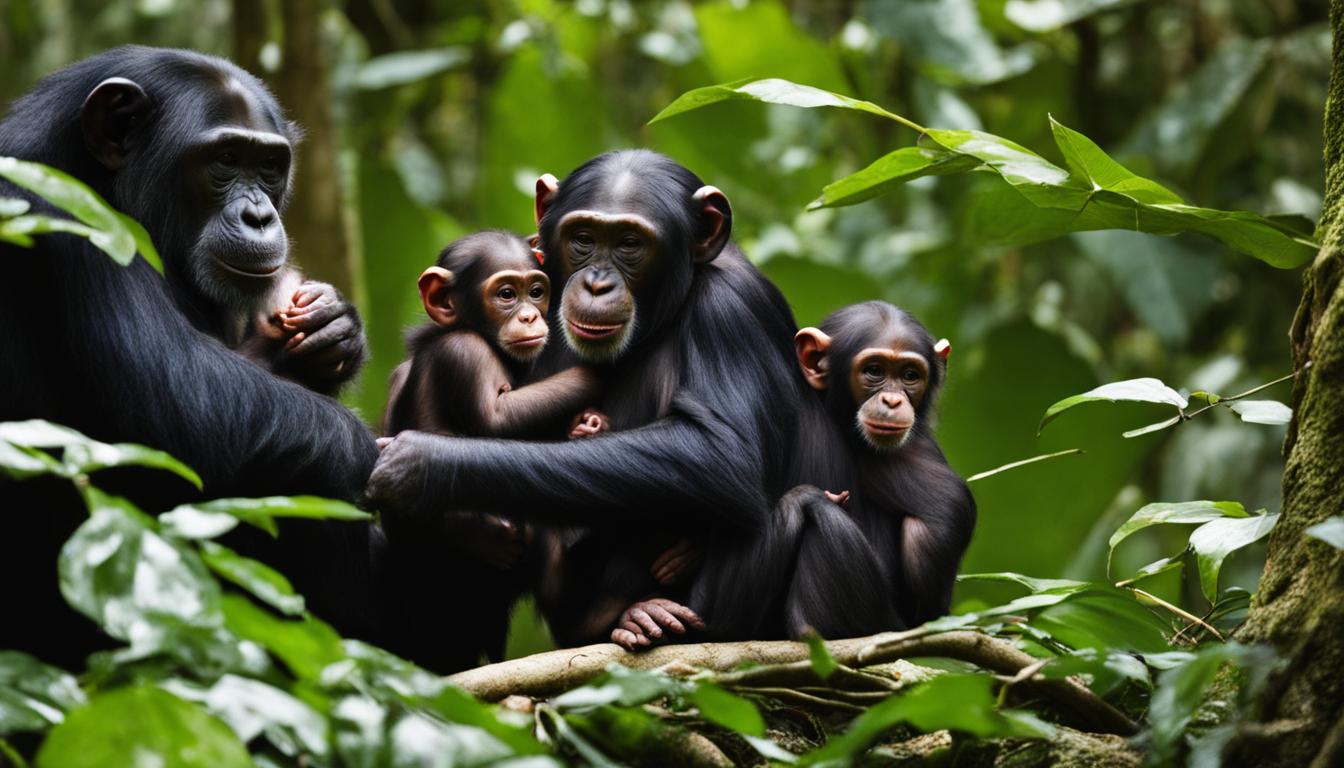Chimpanzee reproduction is a fascinating subject, providing insights into their complex social structures and evolutionary history. In this article, we will explore the mating behavior, breeding habits, and reproductive cycle of chimpanzees.
Chimpanzees breed throughout the year, ensuring their population continues to thrive. Understanding their reproductive patterns is key to comprehending their unique social dynamics.
Chimpanzee mating behavior involves a polygynandrous mating system, where females mate with multiple males. Their breeding habits are influenced by various factors, including age, social status, and resource availability.
Female chimpanzees have menstrual cycles similar to humans, coming into estrus every 36 days unless they are pregnant. After a gestation period of 8 months, they give birth to a single offspring every three to four years.
Throughout this article, we will delve deeper into the reproductive anatomy of chimpanzees, the factors affecting their reproduction, and their unique mating behaviors and strategies.
Chimpanzee Reproductive Anatomy
Chimpanzees, our closest relatives in the animal kingdom, share many similarities with humans when it comes to reproductive anatomy. Females have a uterus, ovaries, and a menstrual cycle similar to humans. They have external genitalia that undergo swelling and changes in shape and color during ovulation, indicating their fertile period. Males, on the other hand, possess testes, a penis, and produce sperm for fertilization.
Chimpanzee reproductive anatomy is remarkably similar to our own, highlighting the evolutionary connection between our species. Their reproductive system allows for successful reproduction and the continuation of their lineage.
In contrast to our common understanding, chimpanzee reproductive anatomy is not vastly different from that of humans. Despite our many differences, this similarity in reproductive anatomy can provide insights into the shared evolutionary history and reproductive strategies of both species.
| Chimpanzee Reproductive Anatomy | Human Reproductive Anatomy |
|---|---|
| Uterus | Uterus |
| Ovaries | Ovaries |
| Menstrual Cycle | Menstrual Cycle |
| Swelling and changes in genitalia during ovulation | Swelling and changes in genitalia during ovulation |
| Testes | Testes |
| Penis | Penis |
| Sperm production | Sperm production |
Chimpanzee Reproductive Anatomy
Understanding the reproductive anatomy of chimpanzees is essential for comprehending their reproductive behaviors and strategies. The similarities between chimpanzee and human reproductive anatomy demonstrate the shared evolutionary path between our species and shed light on the complex nature of reproduction in primates.
Factors Affecting Chimpanzee Reproduction
Various factors can impact the reproduction of chimpanzees. Age plays a crucial role, with females typically reaching sexual maturity around 10-13 years and males around 12-15 years. Social status within the group also influences reproductive success, as higher-ranking males often have better access to mating opportunities. Additionally, the availability of resources such as food and habitat can significantly affect chimpanzee reproduction.
Research has shown that older female chimpanzees have a higher likelihood of giving birth to healthy offspring compared to younger females. This suggests that age and experience can contribute to reproductive success in chimpanzees. Similarly, dominant males with high social status have greater chances of mating with receptive females, leading to increased reproductive success.
Another crucial factor affecting chimpanzee reproduction is the availability of resources. Adequate food and suitable habitat are essential for maintaining healthy populations and ensuring successful reproduction. Limited resources can lead to competition among individuals, potentially resulting in decreased reproductive rates.
Table: Factors Affecting Chimpanzee Reproduction
| Factor | Description |
|---|---|
| Age | Females reach sexual maturity around 10-13 years, while males reach maturity around 12-15 years. |
| Social Status | Higher-ranking males have better access to mating opportunities. |
| Resource Availability | Adequate food and suitable habitat are crucial for reproductive success. |
Understanding the factors that influence chimpanzee reproduction provides valuable insights into their reproductive strategies and the complex dynamics of their social structures. By studying these factors, researchers can gain a deeper understanding of the evolutionary history of chimpanzees and how they adapt to their environment.

Reproductive Patterns in Chimpanzees
Chimpanzees are known for their unique reproductive patterns, which differ from many other primates. Unlike species with strict breeding seasons, chimpanzees can reproduce throughout the year. This flexibility allows them to take advantage of reproductive opportunities whenever they arise. Female chimpanzees have a long period of fertility and can be sexually receptive even when not near ovulation. This extended period gives them more chances to mate with multiple males, ensuring genetic diversity within the population. The male with the highest social status often has the most opportunities for mating, as he can actively compete with other males for access to females.
The reproductive success of female chimpanzees is typically measured by the number of offspring they produce. While chimpanzees have the potential to give birth to twins, it is relatively rare, and most females give birth to only one offspring at a time. The birth interval, or the time between each birth, is around 4-6 years. This longer time frame allows the mother to invest significant energy and resources into raising each offspring, ensuring their survival and growth. It also highlights the importance of each successful reproductive event and the careful selection of mates.
To better understand the reproductive patterns in chimpanzees, it is crucial to consider their unique mating behaviors. Females engage in consortships, forming temporary alliances with a single male and migrating together for an extended period. During this time, they mate frequently, increasing the chances of successful fertilization. Males, on the other hand, may employ aggression towards females to control mating access and prevent other males from mating with the same female. These complex mating strategies reflect the intricate social dynamics within chimpanzee communities and the competition for reproductive success.
Reproductive Patterns in Chimpanzees – Summary
- Chimpanzees can reproduce throughout the year, with females having a long period of fertility.
- Female chimpanzees can mate with multiple males, promoting genetic diversity within the population.
- Males with higher social status have greater opportunities for mating.
- Most female chimpanzees give birth to one offspring at a time, with a birth interval of around 4-6 years.
- Females engage in consortships, forming temporary alliances with a single male for increased mating opportunities.
- Male chimpanzees may use aggression to control mating access and prevent competition from other males.
| Reproductive Patterns | Description |
|---|---|
| Year-round Reproduction | Chimpanzees can reproduce at any time of the year, unlike species with specific breeding seasons. |
| Extended Fertility | Female chimpanzees have a long period of fertility, allowing for increased chances of successful mating. |
| Multiple Mating | Females can mate with multiple males, promoting genetic diversity within the population. |
| Birth Interval | Most female chimpanzees have a birth interval of 4-6 years, giving each offspring significant care and resources. |
| Consortships | Females form temporary alliances with single males for increased mating opportunities. |
| Mate Competition | Male chimpanzees employ aggression to control mating access and prevent competition from other males. |
Chimpanzee Breeding Habits and Mating Behavior
Chimpanzees exhibit diverse mating behaviors and reproductive strategies, providing fascinating insights into their social dynamics. Females engage in consortships, forming temporary bonds with a single male and mating frequently during that period. This behavior allows females to increase their chances of successful reproduction and provides males with exclusive mating opportunities.
Males, on the other hand, employ aggression as a means to control mating access and prevent other males from mating with the same female. By asserting dominance and intimidating rivals, high-ranking males secure their reproductive success and ensure the passing on of their genetic material.
“Understanding the complex mating behaviors of chimpanzees is crucial for comprehending their evolutionary history and social structures.”
During copulation, chimpanzees often engage in face-to-face or behind-the-female mating positions. Mutual gazing, where the male and female lock eyes, frequently occurs before and during copulation. This behavior is believed to strengthen social bonds and enhance the overall success of reproduction within the group.
By studying chimpanzee breeding habits and mating behavior, researchers gain valuable insights into the intricacies of their reproductive strategies. These findings shed light on the evolutionary adaptations that have shaped the species and highlight the importance of social dynamics in their reproductive success.
| Reproductive Behavior | Description |
|---|---|
| Consortships | Temporary bonds formed by females with a single male to increase mating opportunities. |
| Male Aggression | Males use aggression to control mating access and prevent rival males from mating with the same female. |
| Mating Positions | Chimpanzees mate face-to-face or behind the female, with mutual gazing often occurring during copulation. |
Chimpanzee breeding habits and mating behavior provide a fascinating glimpse into their complex social structures and reproductive strategies. By exploring these aspects, scientists deepen their understanding of the species and the factors that influence their reproductive success.
Conclusion
Chimpanzee reproduction is a fascinating and complex subject. These intelligent primates breed throughout the year, with females exhibiting menstrual cycles and coming into estrus every 36 days. Factors such as age, social status, and resource availability greatly influence their reproductive success.
Chimpanzees have unique mating behaviors and reproductive strategies. Females engage in consortships, forming bonds with a single male and mating frequently during the migration. Males, on the other hand, employ aggression to control access to mates and prevent other males from mating with the same female.
Understanding the reproductive patterns in chimpanzees provides profound insights into their intricate social structures and evolutionary history. By studying chimpanzee reproduction, scientists gain a deeper understanding of these remarkable creatures and their place in the natural world.
What is the Reproduction Cycle of Chimpanzees?
The chimpanzee reproduction cycle typically starts with mating, followed by a gestation period of about 8 months. After giving birth, the mother cares for and nurtures the young chimpanzee until it reaches maturity. Chimpanzees usually reach reproductive age at around 10 to 13 years old.
FAQ
How do chimpanzees reproduce, and what is their reproduction cycle?
Chimpanzees breed throughout the year whenever a female comes into season. Female chimpanzees have menstrual cycles similar to humans and come into estrus every 36 days, unless they are pregnant. They give birth every three to four years after a gestation period of 8 months. Chimpanzees have a polygynandrous mating system, where females mate with multiple males. Usually, only one baby is born, and twins are rare. The mother cares for the baby for the first few years of its life.
What is the reproductive anatomy of chimpanzees?
Chimpanzees have similar reproductive anatomy to humans. Females have a uterus, ovaries, and a menstrual cycle. They have external genitalia that undergo swelling and changes in shape and color during ovulation. Males have testes, a penis, and produce sperm for fertilization.
What factors affect chimpanzee reproduction?
Several factors can influence chimpanzee reproduction. Age is an important determinant of reproductive success, with females reaching sexual maturity around 10-13 years and males around 12-15 years. Social status within the group also plays a role, as higher-ranking males have better access to reproductive opportunities. Availability of resources, such as food and habitat, can also impact reproduction.
What are the reproductive patterns in chimpanzees?
Chimpanzees do not have a strict breeding season and can reproduce throughout the year. Females have a long period of fertility and are sexually receptive even when not near ovulation. They can mate with multiple males, and the male with the highest social status often has the most opportunities for mating. Female chimpanzees typically give birth to one offspring, and the birth interval is around 4-6 years.
What are the breeding habits and mating behavior of chimpanzees?
Chimpanzees engage in a variety of mating behaviors and reproductive strategies. Females can engage in consortships, where they migrate with a single male and mate frequently. Males may use aggression towards females to control mating access and prevent other males from mating with the same female. Chimpanzee mating can occur with the male behind the female or face-to-face. Mutual gazing often occurs before and during copulation.
What can we conclude about chimpanzee reproduction?
Chimpanzee reproduction is a fascinating subject. They breed throughout the year, with females having menstrual cycles and coming into estrus every 36 days. Factors such as age, social status, and resource availability can influence reproductive success. Chimpanzees have unique mating behaviors and reproductive strategies, with females engaging in consortships and males using aggression to control access to mates. Understanding the reproductive patterns of chimpanzees provides insights into their complex social structures and evolutionary history.







